11 Front Lawn Landscaping Ideas
BY SARA PALI | JULY 29TH, 2022 | BLOG, LANDSCAPINGBeautiful front yard landscaping creates an excellent first impression for your guests and increases your property value. Whether you hire a landscaper or choose to DIY your next project, these 11 front lawn landscaping ideas will boost your curb appeal.
In this article, we’ll cover flower beds, water features, outdoor lighting and much more – and highlight the pros and cons of each front yard landscaping idea.
- Rock Gardens
- Vertical Gardens
- Flower Beds
- Edible Landscaping
- Landscape Lighting
- Water Features
- Retaining Walls
- Pergola
- Patios
- Paths and Walkways
- Small Touches
1. Rock Gardens
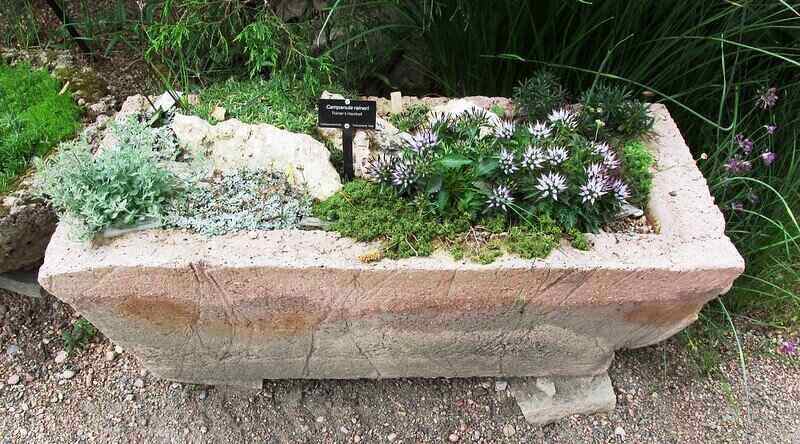
Whether you want to save water or you just have a brown thumb, rock gardens are a low-maintenance front lawn landscape design that can survive in harsh environments. Rocks and pebbles work as a lawn substitute or as a focal point for your front yard. Stone will complement flower beds, ornamental grasses, succulents, and herbs.
Pros
- Low maintenance – Rock-based ground covers are durable and don’t need frequent replacing.
- Tolerate heavy traffic – Foot traffic won’t kill or displace the garden.
- Fewer pests – Bugs and rodents aren’t attracted to the rocks.
Cons
- Labor-intensive – Getting the rocks in place takes a lot of heavy lifting.
- Sink into the soil – Stones are heavy, and you may have to dig them out occasionally.
- Hurricane and tornado risk – Rocks pose a risk of becoming flying projectiles.
- Retain heat – Rocks retain heat in the summer, raising the temperature of your yard (a plus in the winter.)
2. Vertical Gardens
Vertical gardens are perfect for small front yards with limited garden space as they allow you to maximize even the smallest of patios, balconies and front porches. There are numerous vertical garden designs to choose from, including shelves, window boxes, hanging pots, and stackable planters.
Pros
- Accessible for people with disabilities – Vertical gardens don’t require a lot of bending and lifting. They bring plants to higher levels, making them easier to reach and care for. It’s also easier to move the plants.
Cons
- High-maintenance – You may need to water more if your plants are under a balcony or front porch, since your plants may not get enough natural rainfall.
- Water damage – Excess water can flow onto decks or shelving and promote mold. When watering, pathogens from higher plants can trickle down and spread to lower plants.
- Not suitable for deep roots – Snake plants, yuccas, and other heavy botanicals with deep roots need room to spread and will quickly outgrow a vertical garden.
3. Flower Beds
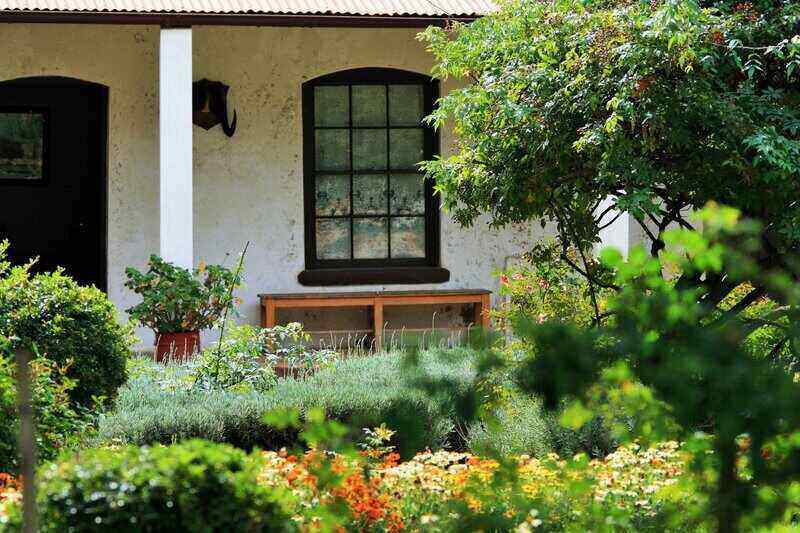
Flower beds add colors and curb appeal to your front yard. Researchers at Texas A&M found people associate colorful landscapes with a better quality of life and improved moods. You can also save on buying floral arrangements by cutting your own flowers.
Pros
- Good for the environment – Plants absorb carbon dioxide and produce oxygen. Showy blooms from hydrangea, sunflowers, tulips, or zinnias attract honey bees and other pollinators. Plant roots stabilize soil and reduce erosion.
Ground covers prevent erosion, prohibit weed growth, and also provide greenery and pops of color. Ornamental grasses offer texture and greenery.
Cons
- High-maintenance – Flower beds often need a lot of watering. By choosing plants native to your area, you can cut down on the amount of maintenance they’ll need. Mulching keeps soils moist, provides nutrients, and makes flower beds look complete.
4. Edible Landscaping
Edible landscaping creates a beautiful and functional yard. Add color by planting an assortment of herbs, fruits, and vegetables. Penn State University has numerous front yard landscaping ideas for edible landscaping. Many flowers like alliums, marigolds, and honeysuckles are edible.
Pros
Adds color – Fruit trees and squash provide flowers before producing mature fruits. Berries and peppers provide a pop of color. Salad greens and herbs provide greenery.
Adds interest – Beans and other vining plants grow on arbors and fences and create interest with differing heights.
Cons
- Attracts pests – Food items attract bugs and birds. Deer and other wildlife may find your garden as appetizing as you do.
- Labor intensive – Some edible landscaping designs take a lot of work and won’t yield any fruit or produce for the first year or two.
- City and HOA restrictions – A few cities and homeowners associations don’t allow edible landscaping in the front yard, so before creating your edible landscape design, check your local regulations.
5. Landscape Lighting
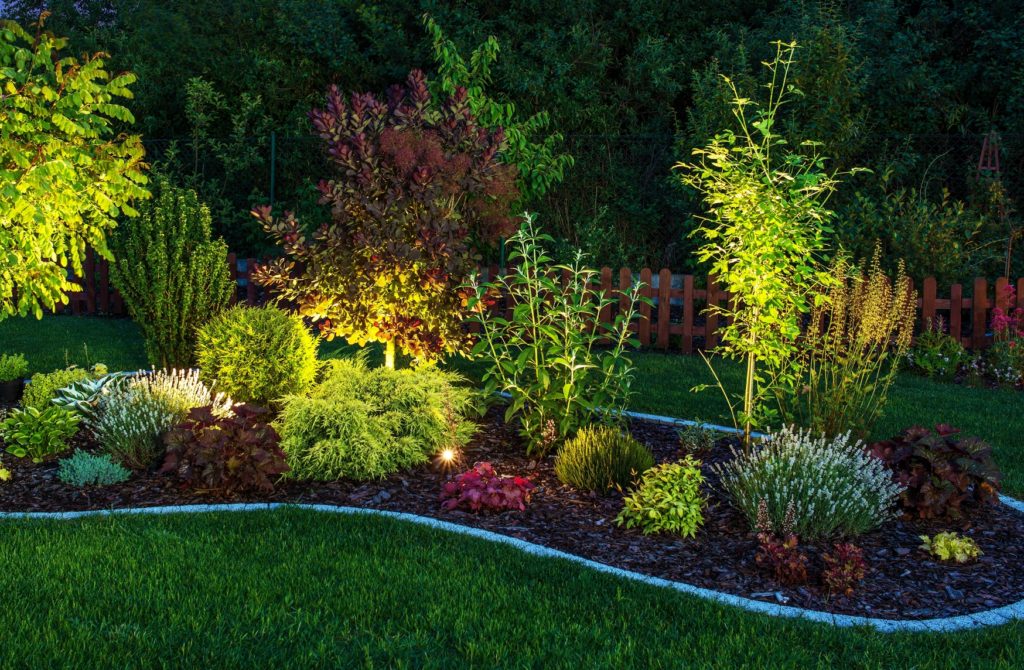
Highlight a focal point in your garden with landscape lighting. Small solar lights will accentuate your front lawn landscaping and won’t raise your power bill.
Pros
- Prevent accidents – Well-lit front walkways and entryways prevent slips and falls.
- Provide security – Lit yards make it harder for a criminal to hide.
Cons
- Needs electricity – Some lighting fixtures require additional electrical access. Solar landscape lighting is an option when electrical access is not available. Electricity use and light bulb replacements are additional factors to consider in the cost of your landscaping design.
6. Water Features
There’s a wide array of water features available for front yard landscaping. You’ll find simple fountains online or in stores that you can place on the front porch or nestle in your flower beds. You can add a koi pond to your front lawn landscape, if you’re willing to spend anywhere between $5,000 to $20,000, but a DIY fountain won’t cost much.
Pros
- Focal point – Ponds create a dramatic focal point drawing attention to your flower beds and other front yard landscaping.
- Provide wildlife habitat – Animals such as dragonflies, frogs, and turtles will flock to your front yard, bringing the sounds of nature with them.
- Recycle Water – The rain that normally runs off into a storm drain can be diverted back to your pond.
- Allow you to accessorize – Waterfalls can be added to your ornamental pond, increasing the circulation of water and the quality of life for fish and plants. A pondless waterfall gives you a focal point and produces the relaxing sounds of running water without the level of maintenance required of a pond.
Cons
- High-maintenance – Fountains and waterfalls need constant care. Ornamental ponds sometimes produce an excess of algae. Fish can overpopulate or develop diseases.
- Need electrical source – You’ll need electrical hookups for filtration. Consider the cost of electricity when choosing a water feature for your front yard landscaping.
- Planning and construction – Ponds require more planning and construction than a fountain, especially if you add aquatic plants and fish.
- Unwanted wildlife – Ponds may attract unwanted critters such as snakes, birds, raccoons, and mosquitos. Snails, turtles, or frogs can overtake a pond and create an unbalanced ecosystem.
7. Retaining Walls
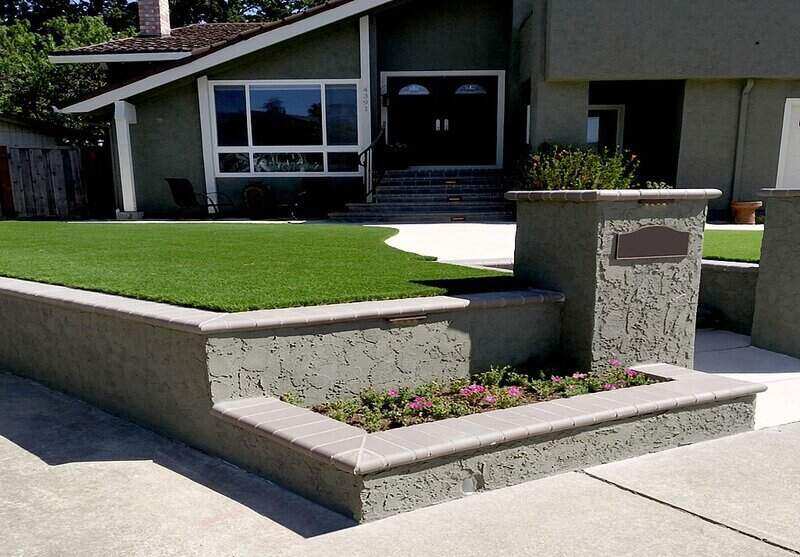
Sloped lawns are prone to erosion. Researchers at Oregon State University recommend retaining walls to help manage soil and water runoff. They can be built to accentuate a flower bed, to make sloping lawns usable, or as borders along homes and patios.
Pros
- Low-maintenance – Well-constructed retaining walls are low maintenance. When designing a retaining wall for your front lawn landscaping, Colorado State University recommends considering materials, placement, drainage, foundations, batter, and anchors. Retaining walls are constructed from wood, stone, bricks, and concrete.
Cons
- Need design work and planning – Some materials are high-maintenance and require a lot of repairs. A poorly designed retaining wall may result in poor water drainage and soil erosion.
8. Pergola
Adding a pergola to your front yard gives you additional living space. These lattice-topped structures come in a number of styles and provide a cover for your patio, without completely blocking out the sun. Pergolas range in price depending on whether you build it yourself or have it custom-built.
Pros
- Shade – You can create a comfortable, shaded area by attaching fabric to the top and sides.
- Privacy – The structure of a pergola will also support vining plants, providing privacy as well as greenery and shade.
Cons
- Maintenance – Over time, your pergola will need repainting. If growing vines, they will need constant trimming and pruning.
- Pests – If you build your pergola out of wood, you risk attracting termites and carpenter ants.
9. Patios
Patios are great at providing an outdoor living space. They can be made from various materials, including concrete, wood, or pavers.
Pros
Durable – A concrete patio will last from 20 to 30 years. A paver patio that expands and contracts in the winter and summer can last up to 50 years. Consider the cost of installation and maintenance when choosing materials for a patio.
Adds Value – A well-designed and built patio can add up to 10% to a home’s value.
Cons
Need maintenance – Patios are an additional space that will need routine cleaning via power-washing. If not properly installed, patios can easily crack.
Cost – A patio for the average home runs about $4,000, depending on its size. The price can go up to as much as $8,000 for higher-end stone and pavers.
10. Paths and Walkways
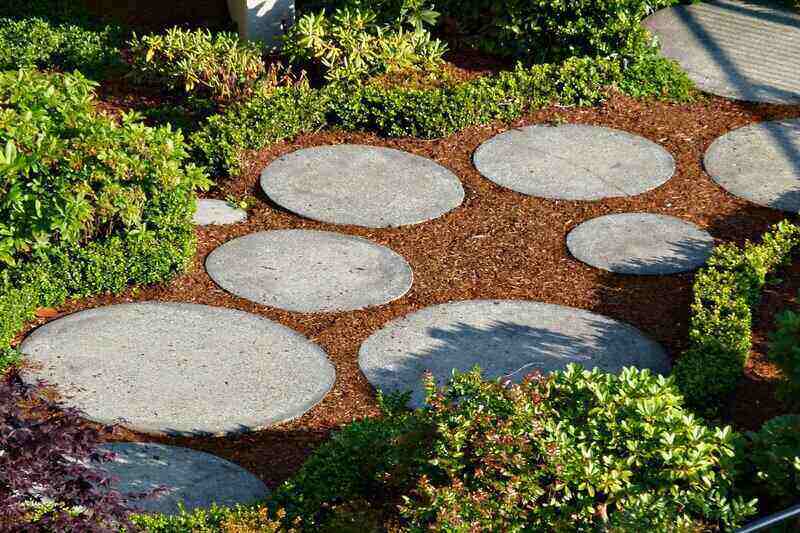
Paths and walkways allow access to different areas of your yard without trampling on grass or flower beds. If these walkways are well-lit, you don’t have to worry about stepping on any critters at night – or breaking your ankle or leg in a fall.
Create paths and walkways throughout your front lawn using pavers, concrete, stones, bricks, gravel, or mulch.
Pros
Adds to front yard design – A pathway will accentuate your front yard landscaping, leading people to the focal points.
Most are easy to install – Gravel, stepping stones, and mulch pathways are easy DIY projects that you can complete in a day. Poured concrete paths are harder to install but make it easier to shovel snow in the winter.
Cons
Weeds – Weeds grow between bricks and stepping stones. Concrete and pavers are more labor intensive, but it’s easier to remove weeds between sections.
Erosion – Mulch and gravel may wash away in heavy rains. Pavers and stone are more durable but sometimes become slippery when wet.
Can Crack – Fluctuating temperatures in the winter can cause concrete and some brick pavers to crack.
11. Small Touches
- Birdhouses, bird baths, and bird feeders – These features attract all kinds of birds and wildlife, including deer and squirrels. These structures come in a variety of materials, colors, and styles.
- Garden art – Metal structures, wind chimes, statues, looking glasses, and wind vanes showcase your style and give your yard a unique vibe. Materials such as old wagons, painted rocks, and chairs can be upcycled as decorative accessories.
- Update accessories – Paint your front door a new, exciting color. Upgrade your mailbox with a new color or design a rock or brick enclosure. Create a focal point for your home’s address numbers with planters, landscape lighting, or frames.
- Power wash – Clean patios and walkways improve your curb appeal.
These 11 front-yard landscaping ideas will boost your property value, but they will require upkeep and maintenance.
Frequently Asked Questions About Front Lawn Landscaping
1. Does front lawn landscaping increase my home’s value?
Yes. Researchers at Virginia Tech found that landscaping significantly increases the value of homes, resulting in a higher selling price, anywhere from 5.5 to 11.4% These increases varied by geographic location and landscaping projects.
2. When is the best time of year to begin front lawn landscaping?
Planting trees, shrubs, and perennial plants in the fall allows them to establish their roots before spring. Installing non-organic landscaping, such as hardscaping, can take place any time during the year. Winter isn’t a good time to install retaining walls because ice and snow may affect the integrity of structures like retaining walls.
3. Will my front yard provide curb appeal only in spring and summer?
Not necessarily. Choose plants with different bloom cycles and foliage colors to create front lawn landscaping that’s visually stimulating year-round.
Evergreens like boxwood provide greenery year-round. Tulips, daffodils, zinnias, roses, and hydrangea bloom in the spring and summer. Aster, begonias, pansy, and hellebores bloom at different times in the fall and winter.
Need more ideas to increase your curb appeal? We can help you find a landscaping professional near you to help.
Main photo credit: pxHere | CC0 1.1